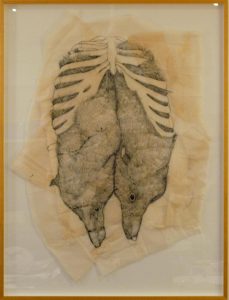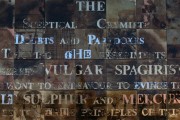Claire Marsh is also an exhibitor in the Helpmann Exhibition. I love drawing and this is what initially led me to explore her work with greater depth. I loved her haphazard patterned line work and the consummate brevity within her drawings.

Claire Marsh, “Untitled 1”, 2011, squid ink on vellum, hair, fur, thread, 18 x 35 cm, (photograph by James Field, courtesy of ACSA)
I must say that I was surprised by what I uncovered as I explored her work further. Claire’s work primarily explores the theme of metamorphosis. In particular, she looks at bodily ambiguity and the feelings associated with trauma. I knew from looking at her work that there were deep feelings of pain and loss accompanied with feelings of survival. I had a sense that there must have been some cathartic happening in her life that triggered such a poignant response. Only after I was able to delve into her blog and gain further information did it become clear to me. At the age of 18 she was involved in a boating accident that left her a paraplegic. Faced with the diagnosis that she would never walk again she was led to explore other medical options overseas. In particular, she underwent stem cell therapy currently only available in China. Now, after what appears to have been extensive treatment she has partial use of her legs and is able to walk. Her struggles to come to terms with her changed life are admirably reflected in her work.

“Shelter” is an amazing womb like creation by Marsh which is reminiscent of a cocoon. Within its form one can see the outline of spinal bones. In contrast with the furry exterior, the inside is smoothed and more reminiscent of the interior of a body cavity. The work is organic in origin as it is essentially composed of a variety of skins yet it is constructed and moulded using bees-wax. The tanned skins suggest death by their very nature yet in the context of this creation they have been turned into a device for renewal and regeneration. There is an unmistakable connection between this creation and the traumatic experiences the artist has faced. “Shelter”, in its cocoon like form is broken, what was within has burst forth. What is left is a husk, a shell of what once was. Marsh is fond of using materials which had once had a different existence. Her drawings are from squid ink; she uses human hair, skins and beeswax. Such materials still contain within their form the remnants of what they once were. They carry a kind of baggage that the viewer uses to engage with the work.
“Furry on the inside” is a pen and ink drawing that utilises the element of line to show both texture and form. Her application is haphazard and the surface is crinkled; folded and ravaged. I remember a story titled “Grandad’s Gifts” by Paul Jennings; I used to read it to my oldest child (until he had nightmares). In the story, a fox skin is brought back to life by a small boy who would feed it lemons from a tree in the yard. This tree was also the place where fox’s remains were buried years before. Grandad, it turns out was buried under another less successful tree, its fruit withered and old. At the end of the story the fox is all but revived (excepting the eyes) when the larger tree is cut down. The only fruit the boy can feed it comes from the tree under which his grandad was buried. At the end of the story the fox runs back into the wild but not without a glance back at the boy. This is the point where he sees the unmistakable eyes of his grandfather where the fox’s should have been. This story has an obvious association with Claire’s work. “Furry on the Inside” explores renewal and regeneration but also there is a dual nature to the fox. This dual nature is explored by Marsh with a hint from the title. It refers to a piece of feminist literature by Angela Carter titled; “The company of wolves”. The movie version of which contains a line which Marsh has used in her title. Furry on the inside refers to the animalistic nature of human beings which lies dormant until such time as it is awakened. The two foxes are drawn in such a similar manner that at first glance they seem the same yet upon closer inspection they are different. The ink on the left fox has been allowed to bleed and permeate the folds upon the surface. As if the paper itself were wounded. In many ways the foxes mirror each another and perhaps this is the intention. Through this work we can see the dual nature of our existence, the self and other. Particularly though for Marsh there is an indication and tension between what was and when will be. These foxes are in the process of regeneration; their buttoned eyes stare out blankly at us. I am unable to truly connect with the personality of the image because of this and I believe this was Marsh’s intention. The animal nature into which we must, in times of trauma, transform has difficulty communicating.
Claire Marsh is only really at the beginning of her career. Her work is a reminder that all artists work is essentially a self-portrait. Within her artist statement Claire sums up the nature of her work perfectly; “Yet in their marginal states, born from trauma and the damaged body, they also express a tentative hope, teetering on hopelessness, for regeneration; for the chance to be whole again.”




I’m deeply touched and speechless. Lots for me to think about in this poignant and beautiful work…
I remember Paul Jennings’ stories…properly disturbing and gripping tales. Love Claire’s work too.